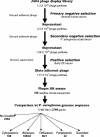Use of phage display to identify potential Pseudomonas aeruginosa gene products relevant to early cystic fibrosis airway infections
- PMID: 15618183
- PMCID: PMC538986
- DOI: 10.1128/IAI.73.1.444-452.2005
Use of phage display to identify potential Pseudomonas aeruginosa gene products relevant to early cystic fibrosis airway infections
Abstract
Pseudomonas aeruginosa airway infections are a major cause of morbidity and mortality in patients with cystic fibrosis. Treatment of established infections is difficult, even with microbiologically active agents. Thus, prevention of infection is an important goal of management. Isolates from cystic fibrosis patients appear to originate from the environment but adapt to the milieu of the airway of the cystic fibrosis patient and evolve toward a common phenotype. Identification of the antigens expressed early in infection may lead to novel targets for vaccine development. Immunogenic peptides were identified in a J404 random nonapeptide phage display library with serum from cystic fibrosis patients obtained within the first year of P. aeruginosa infection. One hundred sixty-five reactive clones were verified by plaque lift assays, and their inserts were sequenced. The sequenced nonapeptides were compared with the published sequence of strain PAO1, identifying homologies to 76 genes encoding outer membrane and secreted proteins. The majority of these were proteins involved in small-molecule transport, membrane structural proteins, and secreted factors. An in silico analysis was performed that suggested that the occurrence of multiple matches to predominantly outer membrane and secreted proteins was not attributable to random chance. Finally, gene expression array data from early isolates of P. aeruginosa from cystic fibrosis patients was compared with the results from phage display analysis. Eleven outer membrane and secreted proteins were common between the two data sets. These included genes involved in iron acquisition, antibiotic efflux, fimbrial biogenesis, and pyocin synthesis. These results demonstrate the feasibility and validity of this novel approach and suggest potential targets for future development.
Figures




References
-
- Burns, J. L., R. L. Gibson, S. McNamara, D. Yim, J. Emerson, M. Rosenfeld, P. Hiatt, K. McCoy, R. Castile, A. L. Smith, and B. W. Ramsey. 2001. Longitudinal assessment of Pseudomonas aeruginosa in young children with cystic fibrosis. J. Infect. Dis. 183:444-452. - PubMed
-
- Burritt, J. B., C. W. Bond, K. W. Doss, and A. J. Jesaitis. 1996. Filamentous phage display of oligopeptide libraries. Anal. Biochem. 238:1-13. - PubMed
-
- Burritt, J. B., M. T. Quinn, M. A. Jutila, C. W. Bond, and A. J. Jesaitis. 1995. Topological mapping of neutrophil cytochrome b epitopes with phage-display libraries. J. Biol. Chem. 270:16974-16980. - PubMed
Publication types
MeSH terms
Substances
LinkOut - more resources
Full Text Sources
Other Literature Sources
Medical

